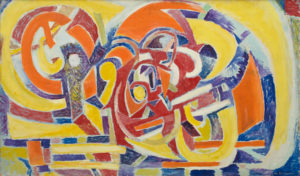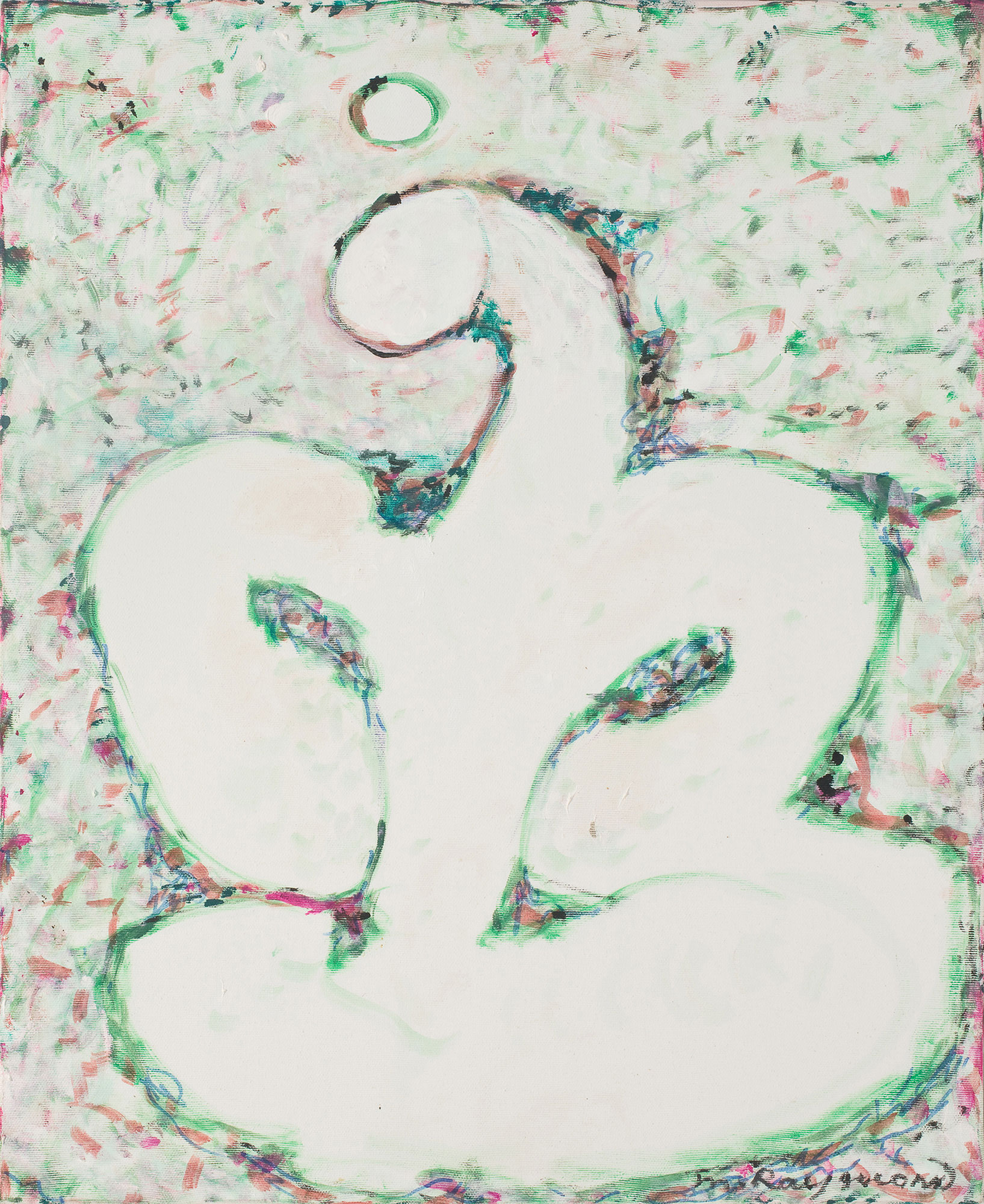Marie Raymond
Organist of light1

UNTITLED – 1986 ca.
Acrylic on panel
65 x 81 cm / 25 9/16 x 31 7/8 in.
Diane de Polignac Gallery, Paris
OU PRISE DE CONSCIENCE DES CHOSES ELLES-MÊMES – 1944
Oil on canvas
32,5 x 41 cm / 12.8 x 16.1 in.
Diane de Polignac Gallery, Paris
1 Pierre Restany, Marie Raymond, Organiste de la lumière, May 1957
THE FORMATIVE YEARS
The painter Marie Raymond was born in the South of France in 1908, in La Colle-sur-Loup. As a teenager, Marie Raymond began practising yoga, which was still uncommon in Europe at the time. The artist also developed an interest in esotericism and the cosmos at a young age. Marie Raymond trained as an artist by painting the subject of landscapes in the South of France. “Then the war set in with all of its anguish, restrictions and tragedies, which we went through under the indifferent sun”2. During this period, Marie Raymond created her Paysages imaginaires [Imaginary Landscapes] (1941–1944) inspired by her walks in the hinterland. These surrealist-inspired landscapes featured sombre palettes, sinuous lines and mysterious titles. It was then that Marie Raymond asked the question: “Doesn’t painting tell the stories of our lost dreams, or those to come?”3
2 Marie Raymond, Notre vie
3 ibid
THE POST-WAR PERIOD IN PARIS
At the end of the war, Marie Raymond chose abstraction. She wrote: “I once again feel the need to express something, but what? The sun is still shining! But there is nothing tangible. How do you piece life back together? This is how the first step towards abstract painting is made. (…) I was trying to construct a world, with the elements of colour and lines: to compose an elsewhere, with what I could feel of the exhilarating light of Space, of the need to live.”4 This abstraction was nourished by memories of the colours and light in the South of France. The paintings of Marie Raymond would be truly radiant.
Based in Montparnasse, the painter Marie Raymond formed friendships with the artists Jacques Villon, Frantisek Kupka, and most importantly Piet Mondrian – with whom she shared her studio. It was probably these artists who encouraged Marie Raymond to explore a more constructed style of abstraction.
Marie Raymond’s palette was composed of warm and luminous colours. She described what lay behind this very personal decision: “I could feel this scattered life, which had to be pieced together as a whole, to express the inner states which, for me, contained the gifts of the Impressionists: the light of the south – Hope. For me, it was that, and an impulse that pushed me to express it. All these scattered harmonies, I had to bring them into the light.”5 In the post-war climate, Marie Raymond turned to the sun’s rays to guide her artistic practice.
In addition to being a painter, Marie Raymond was an art critic, publishing numerous articles. She also wrote poems, which form true counterparts to her luminous paintings.
4 ibid
5 ibid
Lumière
Plusieurs, je te l’ai dit,
Plusieurs se sont brûlés.
Ils ont tourné tout autour,
Plus près, toujours plus près,
Le cercle s’enroulait en piétinant l’espace,
La lumière brillait.
Elle guettait sa proie
Elle, ne savait pas,
Elle brillait.
Elle mangeait la Vie.
Sur des chemins qui n’en sont pas,
Ils étaient à l’abri
Ils étaient affamés
De lumière
Elle, ne savait pas.
Comment lui reprocher
D’être si belle !
Mais où es-tu ?
Depuis que je te cherche.
Je te l’ai dit
Ils l’ont aimée
Elle, … les a brûlés

RYTHMES – 1946
Oil on canvas
82 x 142 cm / 32 1/4 x 55 15/16 in.
Fondation Gandur pour l’art, Geneva
MARIE RAYMOND & IMPRESSIONISM
The artist painter Marie Raymond particularly appreciated the Impressionists, calling the artists “les maîtres de la lumière” [“the masters of light”]. Marie Raymond was struck by their observations of nature and the effects of light: “All of our Impressionists sought out ever closer proximity to nature, to distil the truth around them. Space and light were always drifting between their gaze and the forms they observed, preventing them from fully grasping them. The dissociations of light around things separated them from those things, taking them beyond.”6
Marie Raymond was also attentive to the teachings of Matisse on colour – she was a great admirer of the artist, who she interviewed in 1953 for the Japanese magazine Mizue. Her work evolved during the 1950s, as she adopted a more “naturalist” style.
6 Marie Raymond, Les maîtres de la lumière, published in “Des meesters van het licht”, Kroniek van Kunst en Kultuur (Amsterdam), No. 1, January 1948, pp. 27–28

PRINTEMPS – 1953
Oil on canvas
101 x 82,5 cm / 39 3/4 x 32 1/2 in.
Musée des Arts, Nantes
MARIE RAYMOND: THE COSMOS & ESOTERICISM
In 1957, Pierre Restany wrote about the painter Marie Raymond: “The universe of Marie Raymond retraces the beautiful story of light and its myriad of games through a diffuse space, a sacred place of this complete saturation. Here, the trajectories of the sun’s rays—sometimes direct, sometimes grouped in contradictory nebulae—create the dynamic elements of a subtle meridian atmosphere where the scattered memories of ancient natural structures come together and merge. (…) The journey on which Marie Raymond invites us—in an elevated atmosphere, in the full warmth of her light hues—is steeped with an infinite number of sparkling encounters, where the Berthe Morisot of abstract painting succeeds in bestowing chromatic bursts with that delicate, full touch, that distinctive accent. Her work, imbued with the serene joy of spring mornings, has managed to capture the flavour of a melodious secret (…)”7
7 Pierre Restany, Marie Raymond, Organiste de la lumière, May 1957
Marie Raymond continued her exploration of light through a theme that had fascinated her since her teenage years: the cosmos. Going beyond representations of the effects of light, Marie Raymond wanted to reach the stars: “To bring a world into being, is it not true that stars must be born?” She explained: “I have always remembered a line from an opera, which I heard in Nice. It was Antar, I think. The line, which has stayed lodged in my memory, resonated very strongly with me: ‘And one can, with the beat of a wing, fly away to the Sun’”8.
This line, which profoundly affected Marie Raymond, is evocative of both her fascination with the stars and the dazzling career of her son, Yves Klein.
Indeed, the premature loss of her son in 1962 plunged the luminous Marie Raymond under a blue shadow for quite some time. The artist returned to painting and created a more “psychedelic” style of art that was oriented definitively towards esotericism and the cosmos.
8 Marie Raymond, Notre vie

UNTITLED – 1963 ca.
Oil on canvas
96 x 130 cm / 37 13/16 x 51 3/16 in.
Diane de Polignac Gallery, Paris
Mirage
Le point lumineux dans l’arbre, c’est le reflet de la lampe.
Trois points lumineux dans le ciel,
Trois pigeons semblent voler autour
Les feuilles se balancent au rythme du vent
Dedans, dehors,
Et moi je regarde le mirage.
ABSTRACTION-FIGURES-ASTRES
In 1964, the artist Marie Raymond began painting a series of works that she called Abstraction-Figures-Astres [AbstractionFigures-Stars]. The works in the series were characterised by a restless touch that whirled over the surface of the canvas. In 1966, Georges Boudaille and Jean Cassou wrote about Marie Raymond: “It was a delicate yet powerful melody that was born from the rhythms of colour. What a colourist! So full of vivacity with her reds, pinks and mauves, which developed in harmonious contrast with acid, brutal and luminous greens. From this explosion of violence, subtle poetry was born, full of nuances, which did not fade away when we moved away from the work, and has not faded from our memories ever since.”9
9 Georges Boudaille and Jean Cassou, invitation card for the exhibition
Peintures de 1960 à 1966 de Marie Raymond, 1966
GRANDE LUMIÈRE – 1981
Acrylic on canvas
73,5 x 73,5 cm / 28 15/16 x 28 15/16 in.
Diane de Polignac Gallery, Paris
Ce que je voudrais être
Je voudrais être un rayon,
un rayon qui réchauffe,
un simple rayon
qui pénètre curieux, lumineux,
remarqué et aussi souhaité.
Si on me demandait ce que je voudrais être,
inconnu et présent, insaisissable, serein et joyeux,
un rayon qui vient à la rencontre. Du lointain au point juste.
J’aurais franchi l’Espace.
Il me serait facile de fureter,
de découvrir, de caresser, d’être vu.
Jamais saisi, jamais souillé, je serais pur et pourtant je saurais.
Je saurais qu’on m’aime, j’aimerais.
Ce serait bon d’être un rayon. Venu du Soleil même,
mais un rayon tout rond.
Par le même chemin je reviendrais là-haut,
puis, descendrais encore, inlassablement.
La Terre tournerait, bien sûr.
Alors, je chercherais, là-bas, au-delà de l’ombre.
Je sourirais toujours.
Porté par l’air, sondant le Temps,
je pourrais tout connaître.
Et mon identité, pareille à tant d’autres,
serait ici ou là, solitaire et multiple,
à tout les autres uni
et cependant unique
Si j’étais un rayon !
Marie Raymond’s works once again possessed that mysterious aspect reminiscent of her “surrealist” works from the early 1940s. Playing on the boundaries between abstraction and figuration, the artist populated this imaginary cosmos with anthropomorphic forms. She wrote: “I remember learning that the Persians had practised the cult of Mithra, goddess of light. This cult from antiquity was said to have spread to the ancient city of Lutetia, which is, as everyone knows, our city of Paris today.”10 Even in her darkest moments, Marie Raymond was searching for clarity: “‘The night is not the night’, because there will be dawn, hope”11.
10 Marie Raymond, Les maîtres de la lumière, published in “Des meesters van het licht”, Kroniek van Kunst en Kultuur (Amsterdam), No. 1, January 1948, pp. 27–28
11 Marie Raymond, La nuit de l’été 76, published in +/0 (Brussels), No. 15, December 1976, p. 21
ENFERMÉS DANS LES FORMES – 1976
Acrylic on canvas
92 x 73 cm / 36 1/4 x 28 3/4 in.
Diane de Polignac Gallery, Paris
Dans le soleil d’hiver
Les branches cassent, le ciel
Et les couleurs crues crient
Comme les cuivres
Dans la gaze de brume
Où perce l’astre clair
Je pousse une pensée
à droite, une pensée à gauche
Comme l’arbre ses branches
Qui tend les bras au ciel
L’arbre qui pense haut
Et le vieux s’est assis
Son visage de bois
A l’arbre identifié
Dans lequel une flamme sombre
Exprime le regret d’avoir vécu à l’ombre.
LA RÊVEUSE – 1984
Acrylic on canvas
61 x 50 cm / 24 x 19 11/16 in.
Diane de Polignac Gallery, Paris
Born under the sun of the South of France, the painter Marie Raymond constructs her work with light. Inspired by nature, the impressionist masters and her passion for the stars, the artist’s paintings evolved throughout her life. The dreamer Marie Raymond thus gave birth to “images that were mirrors of the inner self”.
Mathilde Gubanski
© Mathilde Gubanski / Diane de Polignac Gallery, 2020



